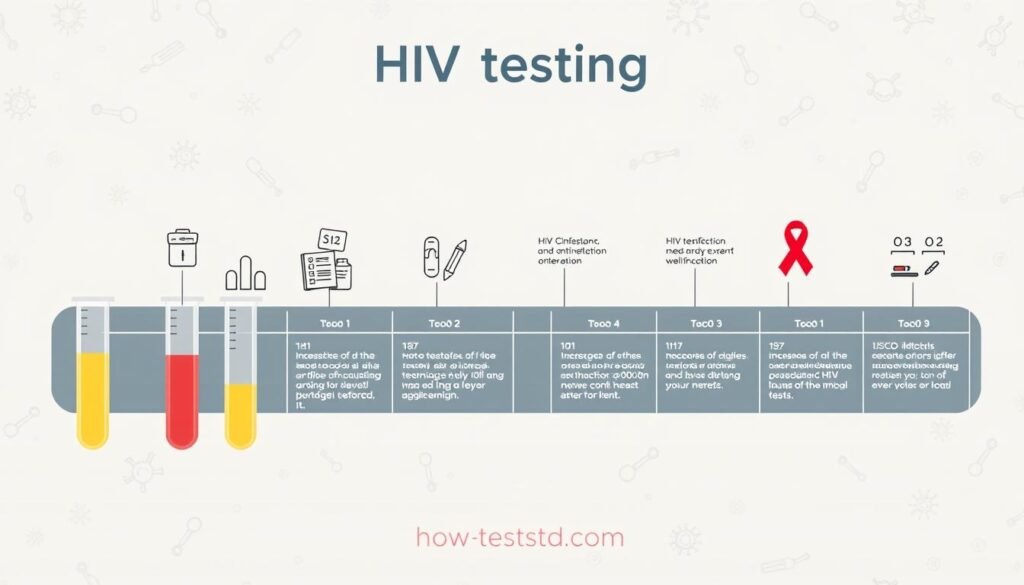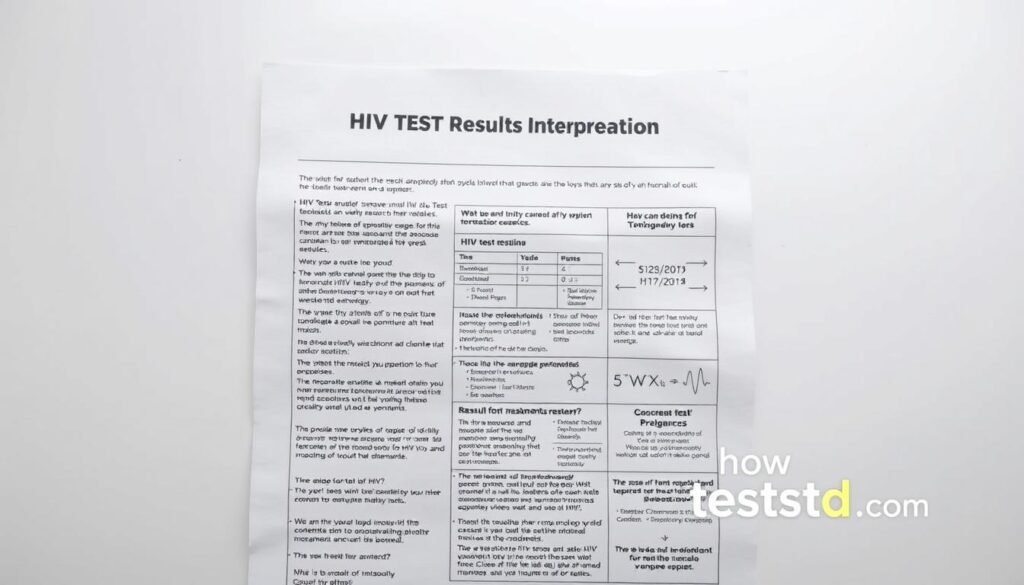STD Testing for HIV Exposure: What You Need to Know
Nearly 1 in 7 people in the United States living with HIV don’t know they have it. This can lead to spreading the disease and delayed treatment. It’s very important to know your status for your health and your partner’s.
Being proactive about your health is key. Don’t wait to get tested. If you test positive, you can start treatment. This helps you live a long, healthy life and keeps others safe.
Key Takeaways
- Knowing your HIV status is key for your health and your partner’s.
- A positive test result means you can start treatment, improving your life.
- Early treatment cuts down the risk of spreading HIV.
- Regular testing keeps you healthy.
- Don’t wait; get tested today to take care of your health.
Understanding HIV and Its Transmission
Knowing about HIV is key for staying safe and healthy. HIV attacks the immune system. If not treated, it can turn into AIDS. HIV spreads through certain body fluids like blood and semen.
What is HIV and How Does It Affect the Body?
HIV harms a type of white blood cell called CD4 cells. These cells help fight off sickness. Getting tested early is very important to manage HIV and stop it from getting worse.
Common Transmission Routes and Risk Factors
HIV mainly spreads through unsafe sex with someone who has it. It can also spread through needle sharing and from mother to child. Risks include having many partners and unsafe sex. For more info, check out this link.
Knowing how HIV spreads helps with sexual health checks and staying healthy.
The Importance of Early STD Testing for HIV Exposure
Early STD testing is very important for HIV exposure. It helps a lot in keeping people healthy. Finding HIV early means you can start treatment fast. This lowers the chance of passing it to others.
Window Periods and Detection Timeframes
The window period is when you might have HIV but tests can’t find it yet. Knowing this time is key for when to get tested.
| Test Type | Window Period |
|---|---|
| Antibody Test | 23 to 90 days |
| Antigen/Antibody Test | 18 to 45 days |
| Nucleic Acid Test (NAT) | 10 to 33 days |
Health Benefits of Early Detection
Finding HIV early through confidential STD testing is a big plus. It lets people start treatment early. This makes them feel better and lowers the risk of passing HIV to others. It also helps them make smart health choices.
Why You Shouldn’t Delay Getting Tested
Waiting too long to get tested can mean missing a chance to act early. Testing right away means HIV-positive people can start treatment fast. This makes them healthier and lowers the risk of spreading HIV.
Types of HIV Tests Available
There are many HIV tests today. Each has its own benefits. Knowing about them helps you pick the right one for you.
Antibody Tests
Antibody tests find antibodies made by your body when it fights HIV. You can get these tests on blood or saliva. But, they’re not good for catching HIV early because it takes time for antibodies to show up.
Antigen/Antibody Tests
Antigen/antibody tests find both antibodies and a part of the virus. This means you can catch HIV sooner than with antibody tests alone. They use blood from a vein or a fingerstick.
Nucleic Acid Tests (NATs)
NATs find the virus’s genetic material. They’re very good at finding HIV early. They’re used when you need to know fast or when other tests don’t work.
Rapid HIV Testing Options
Rapid tests give results in 20-30 minutes. They use blood from a fingerstick or saliva. Rapid tests are great for quick answers. You can even use some at home.
Home Testing Kits
Home kits let you test for HIV at home. They use a fingerstick blood sample. After sending it to a lab, you get your results online or by phone. They’re easy and private for testing.
Learning about HIV tests helps you take care of your health. You can choose the best test for you.
When Should You Get Tested for HIV?
Knowing when to get tested for HIV is very important. It helps keep you and others safe. Getting tested early is key to HIV prevention services.
After Possible Exposure
If you think you might have been exposed to HIV, like through sex without protection, you should get tested. The Centers for Disease Control and Prevention (CDC) say to test 2-4 weeks after. This is when you can most likely find out if you have the virus.

Testing Frequency for Different Groups
The CDC says everyone between 13 and 64 should get tested for HIV at least once. If you have many sex partners or use needles, test every 3-6 months. You can find an STD clinic near me to help you stay on track with testing.
| Risk Group | Recommended Testing Frequency |
|---|---|
| General Population (13-64 years) | At least once |
| High-Risk Individuals | Every 3-6 months |
Where to Get Tested for HIV in the United States
If you’re worried about HIV, many places offer tests across the country. Getting tested is key to keeping your sexual health safe and stopping HIV spread.
Primary Healthcare Providers
Your doctor is a great place to start for HIV tests. They offer confidential HIV testing and advice as part of your care.
STD Clinics Near You
STD clinics focus on sexual health, including HIV tests. They often have free or low-cost testing, making it easy for many to get tested.
Community Testing Centers
Community centers for HIV testing help those who need it most. They might do rapid HIV testing and give advice too.
Finding Testing Locations in Your Area
To find a testing place near you, check the CDC’s Get Tested website. Just type in where you are. You’ll get a list of places, their contact info, and what they offer.
Confidential STD Testing Services
Confidential STD testing services let people get HIV tested safely. They don’t have to worry about being judged or having their privacy broken. Keeping things private is very important for those getting tested.
Anonymous vs. Confidential Testing Options
There are two main choices for HIV testing: anonymous and confidential. Anonymous testing doesn’t connect the test result to your name. Confidential testing does link it to you, but it’s kept safe by law.
Which one you choose depends on what you prefer and the rules of the testing place.
Privacy Protections for HIV Testing
There are strong privacy rules for HIV testing. These rules help keep your personal info safe. Testing places and doctors must follow these rules very carefully.
| Protection | Description |
|---|---|
| Confidentiality Laws | Protects test results from unauthorized disclosure |
| Secure Storage | Test results are stored securely to prevent unauthorized access |
| Authorized Access | Only authorized personnel have access to test results |
What to Expect During the Testing Process
Learning about HIV testing can make you feel less worried. The whole process is detailed. It covers the test and the support you’ll get along the way.
Pre-Test Counseling and Consultation
A healthcare expert will talk to you before the test. This talk is key. It explains how the test works and answers your questions. You’ll learn about the process and what the results mean.
The Testing Procedure Step by Step
The test might be a blood draw or an oral swab. The exact method depends on the test type. For example, rapid tests give quick results. Other tests might take a few days.
| Test Type | Sample Collection | Result Timeframe |
|---|---|---|
| Rapid HIV Test | Blood or Oral Swab | 20-30 minutes |
| Antibody Test | Blood Draw | 1-3 days |
| Nucleic Acid Test (NAT) | Blood Draw | 1-2 weeks |
Post-Test Counseling and Support
After getting your test results, you’ll get more counseling. This talk is important. It helps you understand your results and what to do next. You’ll also learn about HIV prevention and keeping your sexual health safe.
Understanding Your HIV Test Results
Knowing how to understand your HIV test results is key to taking care of your health. HIV test results can be positive, negative, or unclear. It’s important to know what each result means for your next steps.
Interpreting Positive Results
A positive HIV test result means you have HIV. But, with the right treatment, you can live a long, healthy life. You’ll need to confirm this with another test.
What to do next if you test positive:
- Get a second test to confirm.
- Talk to a doctor about treatment.
- Let your sexual partners know to get tested.
Interpreting Negative Results
A negative HIV test result is good news. It means no HIV was found in your blood. But, if you’ve been exposed recently, the test might not catch it yet.
Things to think about with a negative result:
- Learn about the test’s window period.
- Think about getting tested again if you’ve been exposed.
- Keep practicing safe sex to avoid future risks.
Dealing with Inconclusive Results
An inconclusive result means the test couldn’t say for sure if you have HIV. This could be because you’re in the early stages or have another health issue.
What to do with an inconclusive result:
- Get tested again after a few weeks or months.
- Talk to a doctor for advice.
- They might suggest other tests.
| Result Type | Meaning | Next Steps |
|---|---|---|
| Positive | HIV infection detected | Confirm diagnosis, consult healthcare provider, notify partners |
| Negative | No HIV detected | Understand window period, consider repeat testing, practice safe sex |
| Inconclusive | Status unclear | Repeat testing, consult healthcare provider, consider alternative testing |

HIV Prevention and Treatment Services
HIV prevention and treatment services are key in fighting HIV. They include many strategies to stop new infections and help those with HIV.
Pre-Exposure Prophylaxis (PrEP)
Pre-Exposure Prophylaxis (PrEP) is a medicine for those at high HIV risk. It’s taken daily and is very effective. The CDC says PrEP can cut HIV risk by up to 92%.
“PrEP is a powerful tool in the fight against HIV, giving a highly effective way to prevent infection when used right.”
Post-Exposure Prophylaxis (PEP)
Post-Exposure Prophylaxis (PEP) is emergency medicine for HIV exposure. It must start within 72 hours and works well if taken right.
| Timeframe | Action |
|---|---|
| Within 72 hours | Start PEP |
| 28 days | Complete PEP course |
Safe Sex Practices
Safe sex is key to prevent HIV. This means using condoms correctly, having fewer partners, and not sharing needles.
- Use condoms correctly all the time.
- Get tested for HIV and other STIs often.
- Have fewer sexual partners.
Treatment Options for HIV-Positive Individuals
For those with HIV, antiretroviral therapy (ART) is the main treatment. ART is a mix of HIV medicines taken daily. It keeps the virus low, improving health a lot.
Resources and Support for People Affected by HIV
Getting the right help is key for those with HIV. Many groups and doctors offer help. They have services for everyone’s needs.
Medical Care and Treatment Programs
Medical care is very important for HIV. You can get antiretroviral therapy (ART) and more from primary healthcare providers and HIV clinics. These help keep you healthy and stop the disease from getting worse.
Support Groups and Counseling Services
Support groups let people share and get support. Counseling services help with the emotional side of HIV. You can find these at community centers and STD clinics near me.
Financial Assistance Programs
There’s help for those who can’t afford HIV treatment. The AIDS Drug Assistance Program (ADAP) helps pay for meds and other costs.
Educational Resources
Learning about HIV is very important. Groups offer workshops, online courses, and materials. They help you understand and manage your HIV.
Conclusion: Taking Control of Your Sexual Health
Getting tested for HIV is very important. It helps you know your health status. This way, you can make smart choices for your well-being.
STD testing for HIV is easy to find. Using these services helps catch HIV early. This is key for treatment.
Pre-Exposure Prophylaxis (PrEP) and Post-Exposure Prophylaxis (PEP) can also help. They lower the chance of getting HIV.
Being proactive about your health is key. It helps prevent HIV and ensures you get treatment if needed. Start by getting tested and learning about HIV prevention services.
FAQ
What is HIV and how is it transmitted?
HIV is a virus that harms your immune system. It spreads through blood, semen, vaginal fluids, and breast milk. This usually happens during unprotected sex or when sharing needles.
How soon after exposure should I get tested for HIV?
You should test for HIV soon after exposure. Most tests can find the virus in 18-45 days. But, some tests might not find it right away. So, test at 3 months and again at 6 months for sure results.
What are the different types of HIV tests available?
There are many HIV tests out there. You can find antibody tests, antigen/antibody tests, nucleic acid tests (NATs), rapid HIV tests, and home testing kits. Each has its own benefits and uses.
What is the difference between anonymous and confidential HIV testing?
Anonymous testing keeps your identity private. Confidential testing also keeps your result private but links it to you. You can find both at testing sites.
What should I expect during the HIV testing process?
Expect counseling before and after the test. The test itself is usually a blood draw or oral swab. Then, you’ll get counseling about your results and what to do next.
What does a positive HIV test result mean?
A positive result means you have HIV. It’s very important to see a doctor to confirm this. They will talk to you about treatment options.
How can I prevent HIV infection?
To prevent HIV, use PrEP, condoms, and don’t share needles. Also, get tested often for HIV and other STDs.
What resources are available for people living with HIV?
People with HIV can find many resources. This includes medical care, treatment programs, support groups, and counseling. There are also financial help and educational resources to improve their life.
How often should I get tested for HIV if I’m at high risk?
If you’re at high risk, test every 3-6 months. This catches infections early. It helps you get treatment quickly and prevents spreading it to others.
Can I get HIV testing at my primary healthcare provider’s office?
Yes, many doctors’ offices offer HIV testing. You can make an appointment to talk about testing.
Are there any free or low-cost HIV testing options available?
Yes, many places offer free or low-cost testing. Look online or call your local health department to find a testing site near you.


